Abstract
Botulism is widely known to result from ingestion of food containing botulinum neurotoxin produced in situ by certain strains of Clostridium botulinum. Infant botulism caused by C. botulinum, unlike the food-borne intoxication, is the toxicoinfectious form of botulism (S. S. Arnon, p. 331-345, in G. E. Lewis, ed., Biomedical Aspects of Botulism, 1981). The strain of Clostridium baratii implicated in infant botulism produced a neurotoxin that was neutralized with antiserum for botulinum neurotoxin serotype F (J. D. Hall, L. M. McCroskey, B. J. Pincomb, and C. L. Hatheway, J. Clin. Microbiol. 21:654-655, 1985). We developed a procedure to culture the toxigenic C. baratii (strain 6341) in dialysis bags and a simple purification scheme (precipitation of 900-ml culture supernatant with ammonium sulfate and two anion-exchange chromatographic steps at pH 5.5 and 8.0) that yielded up to 150 micrograms of purified neurotoxin. It is an approximately 140-kDa single-chain protein and has the following sequence of amino acid residues at the N terminus: Pro-Val-Asn-Ile-Asn-Asn-Phe-Asn-Tyr-Asn-Asp-Pro-Ile-Asn-Asn-Thr-Thr-Ile- Leu. Comparison of this amino acid sequence with those of the botulinum neurotoxin serotypes A, B, and E showed 40 to 50% identical residues in comparable positions. The specific toxicity of the neurotoxin, approximately 2 x 10(6) 50% lethal doses for mice per mg of protein injected, was not enhanced significantly by mild trypsinization, although the protease cleaved the neurotoxin within a disulfide loop that generated at least two primary fragments, approximately 47 and approximately 86 kDa, that remained linked by an interchain disulfide. These two fragments resembled the light and heavy chains of the well-characterized neurotoxin serotypes A, B, C, D, E, and F produced by C. botulinum.
Full text
PDF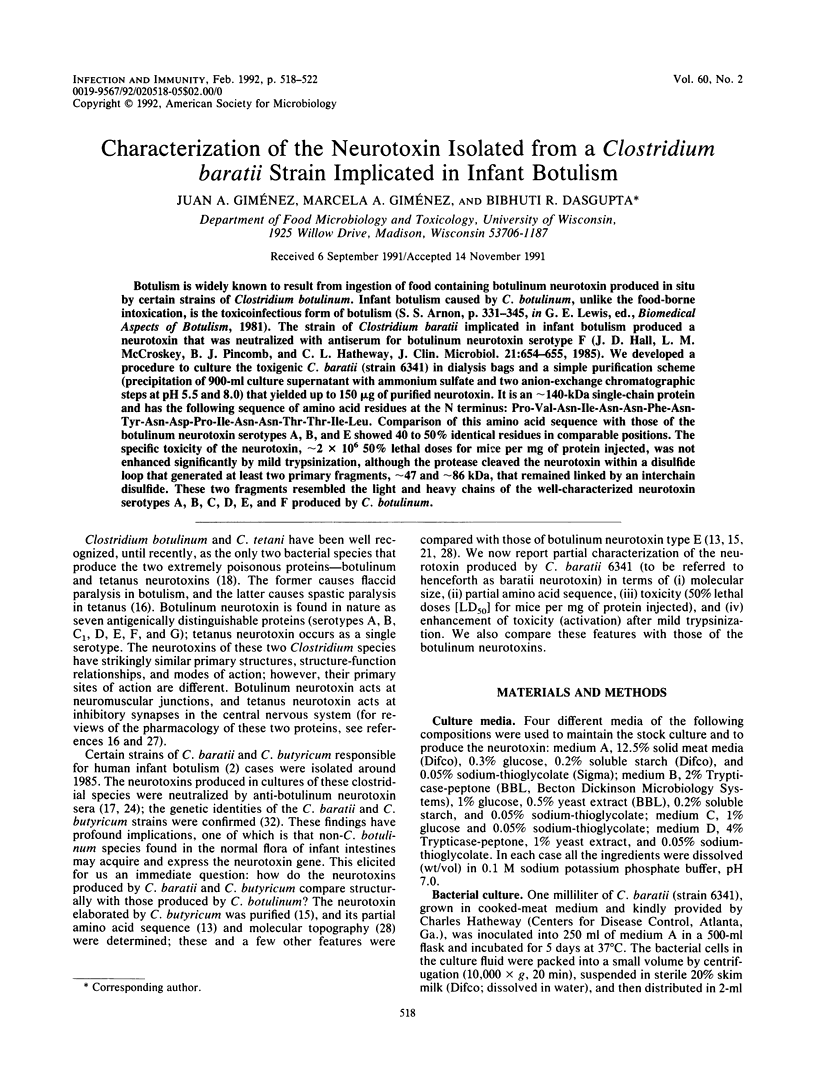
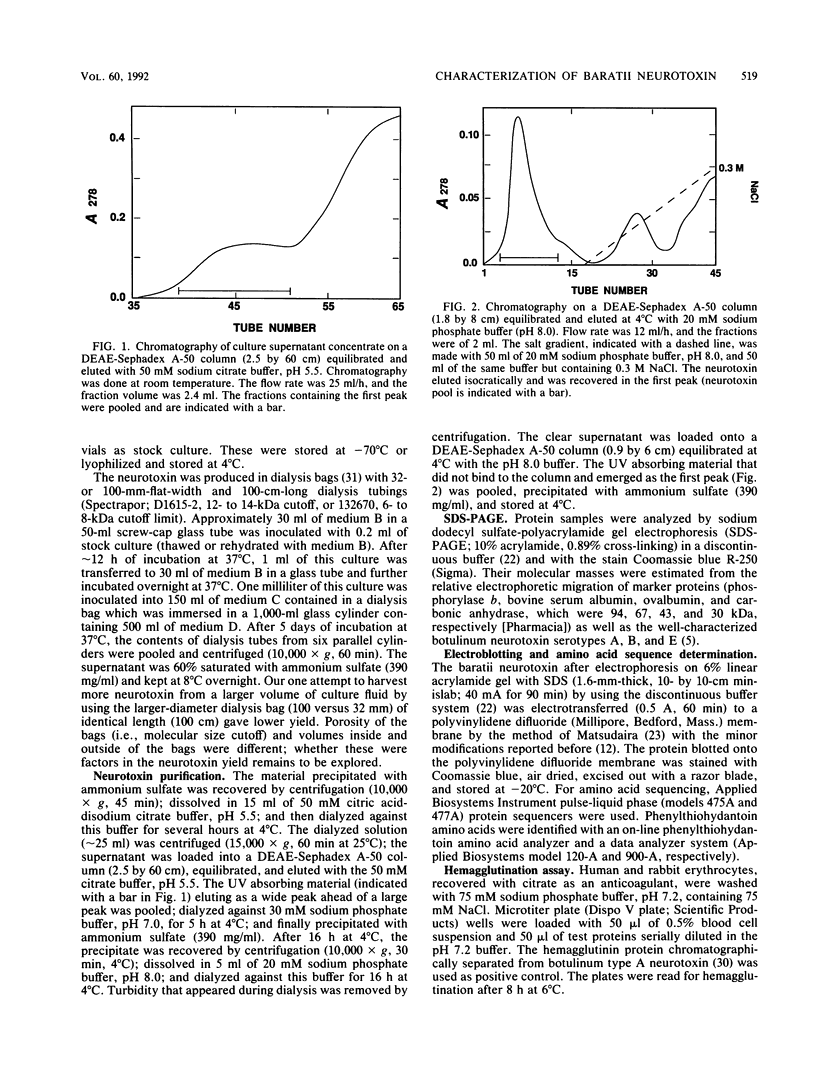
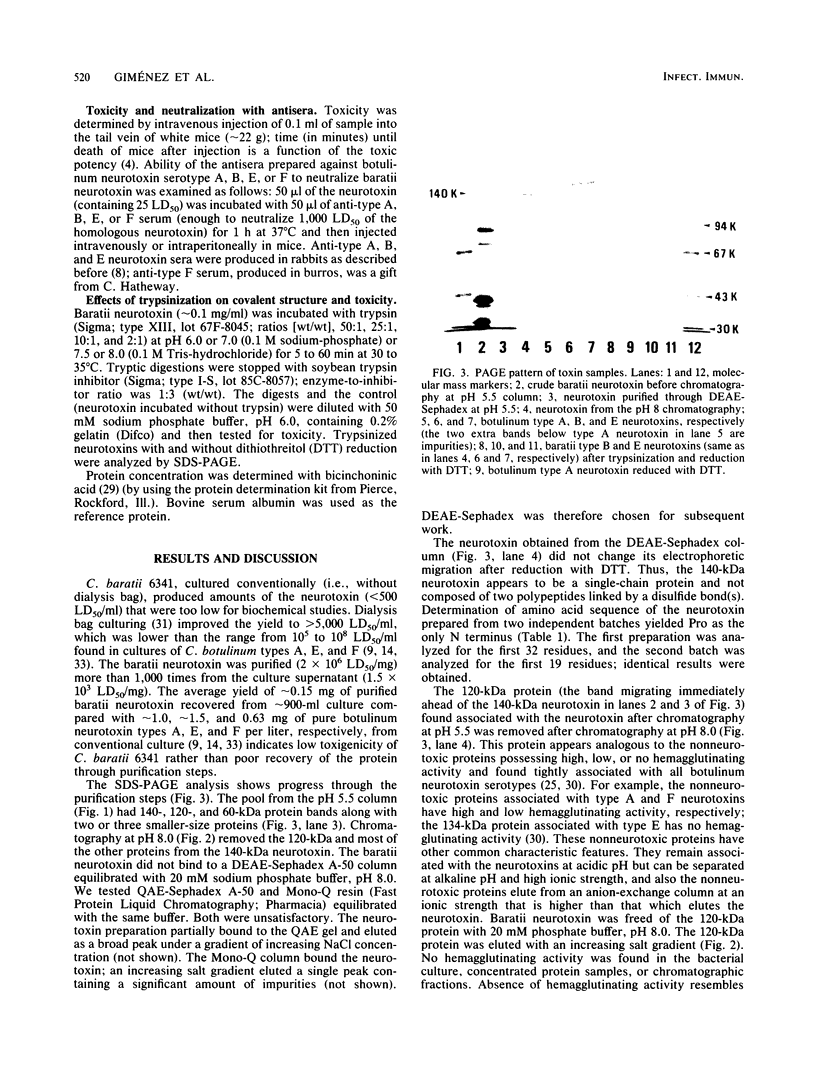
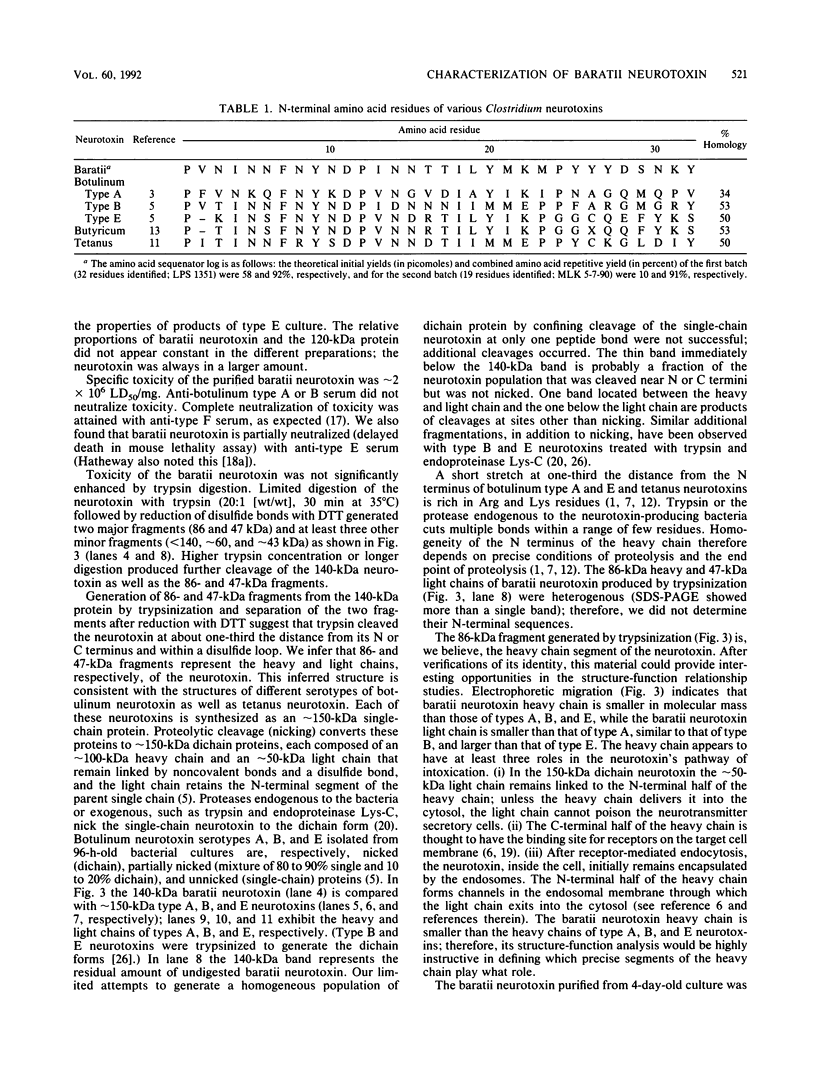
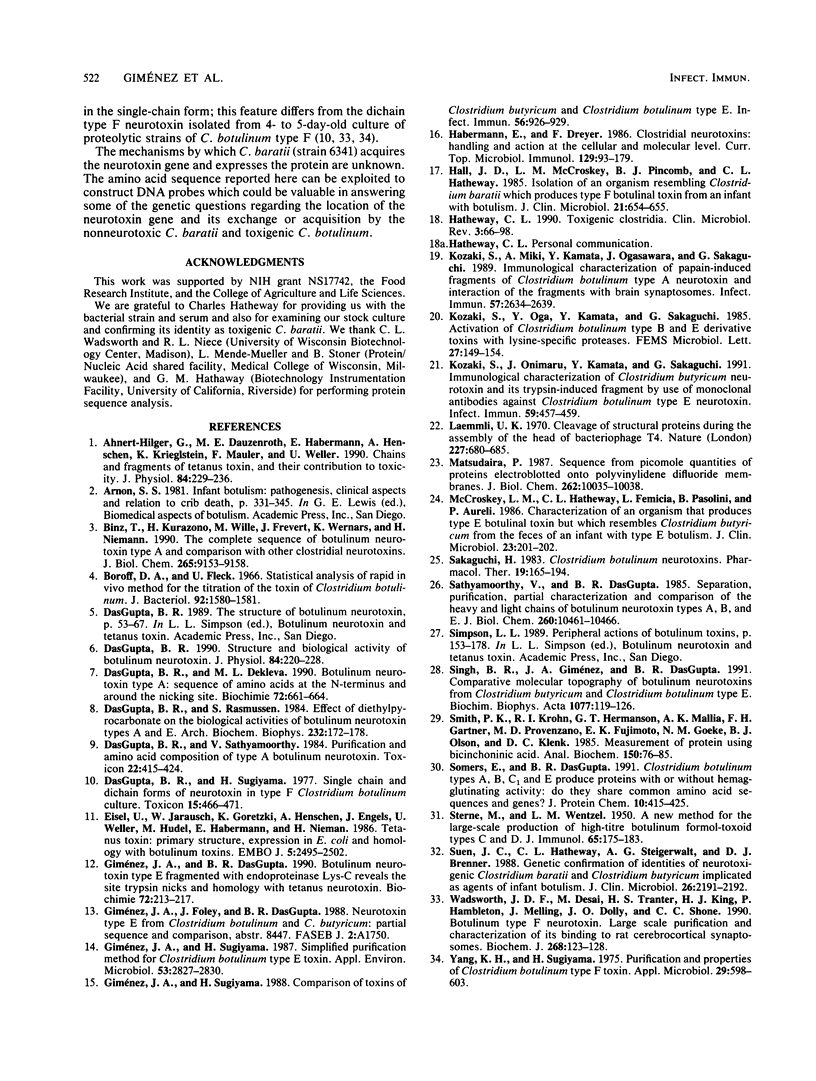
Images in this article
Selected References
These references are in PubMed. This may not be the complete list of references from this article.
- Ahnert-Hilger G., Dauzenroth M. E., Habermann E., Henschen A., Krieglstein K., Mauler F., Weller U. Chains and fragments of tetanus toxin, and their contribution to toxicity. J Physiol (Paris) 1990;84(3):229–236. [PubMed] [Google Scholar]
- Binz T., Kurazono H., Wille M., Frevert J., Wernars K., Niemann H. The complete sequence of botulinum neurotoxin type A and comparison with other clostridial neurotoxins. J Biol Chem. 1990 Jun 5;265(16):9153–9158. [PubMed] [Google Scholar]
- Boroff D. A., Fleck U. Statistical analysis of a rapid in vivo method for the titration of the toxin of Clostridium botulinum. J Bacteriol. 1966 Nov;92(5):1580–1581. doi: 10.1128/jb.92.5.1580-1581.1966. [DOI] [PMC free article] [PubMed] [Google Scholar]
- DasGupta B. R., Dekleva M. L. Botulinum neurotoxin type A: sequence of amino acids at the N-terminus and around the nicking site. Biochimie. 1990 Sep;72(9):661–664. doi: 10.1016/0300-9084(90)90048-l. [DOI] [PubMed] [Google Scholar]
- DasGupta B. R., Sathyamoorthy V. Purification and amino acid composition of type A botulinum neurotoxin. Toxicon. 1984;22(3):415–424. doi: 10.1016/0041-0101(84)90085-0. [DOI] [PubMed] [Google Scholar]
- DasGupta B. R. Structure and biological activity of botulinum neurotoxin. J Physiol (Paris) 1990;84(3):220–228. [PubMed] [Google Scholar]
- DasGupta B. R., Sugiyama H. Single chain and dichain forms of neurotoxin in type F Clostridium botulinum culture. Toxicon. 1977;15(5):466–471. doi: 10.1016/0041-0101(77)90128-3. [DOI] [PubMed] [Google Scholar]
- Dasgupta B. R., Rasmussen S. Effect of diethylpyrocarbonate on the biological activities of botulinum neurotoxin types A and E. Arch Biochem Biophys. 1984 Jul;232(1):172–178. doi: 10.1016/0003-9861(84)90532-0. [DOI] [PubMed] [Google Scholar]
- Eisel U., Jarausch W., Goretzki K., Henschen A., Engels J., Weller U., Hudel M., Habermann E., Niemann H. Tetanus toxin: primary structure, expression in E. coli, and homology with botulinum toxins. EMBO J. 1986 Oct;5(10):2495–2502. doi: 10.1002/j.1460-2075.1986.tb04527.x. [DOI] [PMC free article] [PubMed] [Google Scholar]
- Giménez J. A., DasGupta B. R. Botulinum neurotoxin type E fragmented with endoproteinase Lys-C reveals the site trypsin nicks and homology with tetanus neurotoxin. Biochimie. 1990 Apr;72(4):213–217. doi: 10.1016/0300-9084(90)90075-r. [DOI] [PubMed] [Google Scholar]
- Giménez J. A., Sugiyama H. Comparison of toxins of Clostridium butyricum and Clostridium botulinum type E. Infect Immun. 1988 Apr;56(4):926–929. doi: 10.1128/iai.56.4.926-929.1988. [DOI] [PMC free article] [PubMed] [Google Scholar]
- Giménez J. A., Sugiyama H. Simplified purification method for Clostridium botulinum type E toxin. Appl Environ Microbiol. 1987 Dec;53(12):2827–2830. doi: 10.1128/aem.53.12.2827-2830.1987. [DOI] [PMC free article] [PubMed] [Google Scholar]
- Habermann E., Dreyer F. Clostridial neurotoxins: handling and action at the cellular and molecular level. Curr Top Microbiol Immunol. 1986;129:93–179. doi: 10.1007/978-3-642-71399-6_2. [DOI] [PubMed] [Google Scholar]
- Hall J. D., McCroskey L. M., Pincomb B. J., Hatheway C. L. Isolation of an organism resembling Clostridium barati which produces type F botulinal toxin from an infant with botulism. J Clin Microbiol. 1985 Apr;21(4):654–655. doi: 10.1128/jcm.21.4.654-655.1985. [DOI] [PMC free article] [PubMed] [Google Scholar]
- Hatheway C. L. Toxigenic clostridia. Clin Microbiol Rev. 1990 Jan;3(1):66–98. doi: 10.1128/cmr.3.1.66. [DOI] [PMC free article] [PubMed] [Google Scholar]
- Kozaki S., Miki A., Kamata Y., Ogasawara J., Sakaguchi G. Immunological characterization of papain-induced fragments of Clostridium botulinum type A neurotoxin and interaction of the fragments with brain synaptosomes. Infect Immun. 1989 Sep;57(9):2634–2639. doi: 10.1128/iai.57.9.2634-2639.1989. [DOI] [PMC free article] [PubMed] [Google Scholar]
- Kozaki S., Onimaru J., Kamata Y., Sakaguchi G. Immunological characterization of Clostridium butyricum neurotoxin and its trypsin-induced fragment by use of monoclonal antibodies against Clostridium botulinum type E neurotoxin. Infect Immun. 1991 Jan;59(1):457–459. doi: 10.1128/iai.59.1.457-459.1991. [DOI] [PMC free article] [PubMed] [Google Scholar]
- Laemmli U. K. Cleavage of structural proteins during the assembly of the head of bacteriophage T4. Nature. 1970 Aug 15;227(5259):680–685. doi: 10.1038/227680a0. [DOI] [PubMed] [Google Scholar]
- Matsudaira P. Sequence from picomole quantities of proteins electroblotted onto polyvinylidene difluoride membranes. J Biol Chem. 1987 Jul 25;262(21):10035–10038. [PubMed] [Google Scholar]
- McCroskey L. M., Hatheway C. L., Fenicia L., Pasolini B., Aureli P. Characterization of an organism that produces type E botulinal toxin but which resembles Clostridium butyricum from the feces of an infant with type E botulism. J Clin Microbiol. 1986 Jan;23(1):201–202. doi: 10.1128/jcm.23.1.201-202.1986. [DOI] [PMC free article] [PubMed] [Google Scholar]
- STERNE M., WENTZEL L. M. A new method for the large-scale production of high-titre botulinum formol-toxoid types C and D. J Immunol. 1950 Aug;65(2):175–183. [PubMed] [Google Scholar]
- Sakaguchi G. Clostridium botulinum toxins. Pharmacol Ther. 1982;19(2):165–194. doi: 10.1016/0163-7258(82)90061-4. [DOI] [PubMed] [Google Scholar]
- Sathyamoorthy V., DasGupta B. R. Separation, purification, partial characterization and comparison of the heavy and light chains of botulinum neurotoxin types A, B, and E. J Biol Chem. 1985 Sep 5;260(19):10461–10466. [PubMed] [Google Scholar]
- Singh B. R., Giménez J. A., DasGupta B. R. Comparative molecular topography of botulinum neurotoxins from Clostridium butyricum and Clostridium botulinum type E. Biochim Biophys Acta. 1991 Mar 8;1077(1):119–126. doi: 10.1016/0167-4838(91)90533-6. [DOI] [PubMed] [Google Scholar]
- Smith P. K., Krohn R. I., Hermanson G. T., Mallia A. K., Gartner F. H., Provenzano M. D., Fujimoto E. K., Goeke N. M., Olson B. J., Klenk D. C. Measurement of protein using bicinchoninic acid. Anal Biochem. 1985 Oct;150(1):76–85. doi: 10.1016/0003-2697(85)90442-7. [DOI] [PubMed] [Google Scholar]
- Somers E., DasGupta B. R. Clostridium botulinum types A, B, C1, and E produce proteins with or without hemagglutinating activity: do they share common amino acid sequences and genes? J Protein Chem. 1991 Aug;10(4):415–425. doi: 10.1007/BF01025256. [DOI] [PubMed] [Google Scholar]
- Suen J. C., Hatheway C. L., Steigerwalt A. G., Brenner D. J. Genetic confirmation of identities of neurotoxigenic Clostridium baratii and Clostridium butyricum implicated as agents of infant botulism. J Clin Microbiol. 1988 Oct;26(10):2191–2192. doi: 10.1128/jcm.26.10.2191-2192.1988. [DOI] [PMC free article] [PubMed] [Google Scholar]
- Wadsworth J. D., Desai M., Tranter H. S., King H. J., Hambleton P., Melling J., Dolly J. O., Shone C. C. Botulinum type F neurotoxin. Large-scale purification and characterization of its binding to rat cerebrocortical synaptosomes. Biochem J. 1990 May 15;268(1):123–128. doi: 10.1042/bj2680123. [DOI] [PMC free article] [PubMed] [Google Scholar]
- Yang K. H., Sugiyama H. Purification and properties of Clostridium botulinum type F toxin. Appl Microbiol. 1975 May;29(5):598–603. doi: 10.1128/am.29.5.598-603.1975. [DOI] [PMC free article] [PubMed] [Google Scholar]



